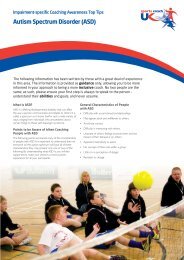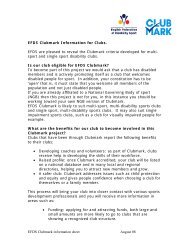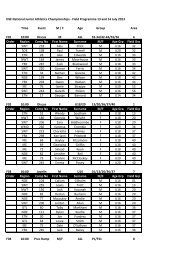OO213 - English Federation of Disability Sport
OO213 - English Federation of Disability Sport
OO213 - English Federation of Disability Sport
- No tags were found...
You also want an ePaper? Increase the reach of your titles
YUMPU automatically turns print PDFs into web optimized ePapers that Google loves.
Early childhood stunting, which is measured aslow height for age, is caused by poor nutritionand diarrhoea. A multi-country study showedthat each episode <strong>of</strong> diarrhoea in the first twoyears <strong>of</strong> life contributes to stunting, 41 which isestimated to affect some 28 per cent <strong>of</strong> childrenyounger than 5 in low- and middle-incomecountries. 42 The consequences <strong>of</strong> stunting, suchas poor cognitive and educational performance,begin when children are very young but affectthem through the rest <strong>of</strong> their lives. However,community-based efforts to improve basic healthpractices have been shown to reduce stuntingamong young children. 43A combination <strong>of</strong> physical factors and attitudesmay adversely affect child nutrition. In somesocieties, mothers may not be encouraged tobreastfeed a disabled child. Stigma and discriminationmay also result in a child with a disabilitybeing fed less, denied food or provided with lessnutritious food than siblings without disabilities.49 Children with some types <strong>of</strong> physical orintellectual disabilities may also have difficultyin feeding themselves, or need additional timeor assistance to eat. It is probable that in somecases what is assumed to be disability-associatedill health and wasting may in fact be connectedwith feeding problems. 50Malnutrition in mothers can lead to a number <strong>of</strong>preventable childhood disabilities. Approximately42 per cent <strong>of</strong> pregnant women in low- andmiddle-income countries are anaemic, and morethan one in two pregnant women in these countriessuffer iron deficiency anaemia. 44 Anaemiaalso affects more than half <strong>of</strong> pre-school agedchildren in developing countries. It is one <strong>of</strong> themost prevalent causes <strong>of</strong> disability in the world– and therefore a serious global public healthproblem. 45 Malnutrition in lactating mothers canalso contribute to poorer infant health, 46 increasingthe risk <strong>of</strong> diseases that can cause disability.Healthy mothers can help reduce the incidence<strong>of</strong> some disabilities and are better prepared tominister to their children’s needs.While malnutrition can be a cause <strong>of</strong> disability,it can also be a consequence. Indeed, childrenwith disabilities are at heightened risk <strong>of</strong> malnutrition.For example, an infant with cleft palatemay not be able to breastfeed or consumefood effectively. Children with cerebral palsymay have difficulty chewing or swallowing. 47Certain conditions, such as cystic fibrosis, mayimpede nutrient absorption. Some infants andchildren with disabilities may need specific dietsor increased calorie intake in order to maintain ahealthy weight. 48 Yet they may be hidden awayfrom community screening and feeding initiatives.Children with disabilities who do not attendschool miss out on school feeding programmes.Water, sanitation and hygieneIt is a widely acknowledged but little documentedfact that throughout the developing world, personswith disabilities routinely face particulardifficulties in accessing safe drinking water andbasic sanitation. Children with physical impairmentsmay be unable to collect water or carryit for long distances; others may find well wallsand water taps too high. Hardware and washroomdoors can be difficult to manipulate andthere may be nowhere to rest the water containerwhile filling it, or there may be nothing to holdon to for balance to avoid falling into a well,pond or toilet. Long or slippery paths and poorlighting also limit the use <strong>of</strong> latrines by childrenwith disabilities.Barriers to persons with disabilities extend beyondphysical and design issues. Social barriers vary indifferent cultures. Children with disabilities <strong>of</strong>tenface stigma and discrimination when using householdand public facilities. Wholly inaccurate fearsthat children with disabilities will contaminatewater sources or soil latrines are frequently reported.When children or adolescents, and particularlygirls, with disabilities are forced to use differentfacilities than other members <strong>of</strong> their households,or are compelled to use them at different times,they are at increased risk <strong>of</strong> accidents and physicalattack, including rape. Issues preventing disabledchildren from accessing water and sanitation inA STRONG FOUNDATION25











